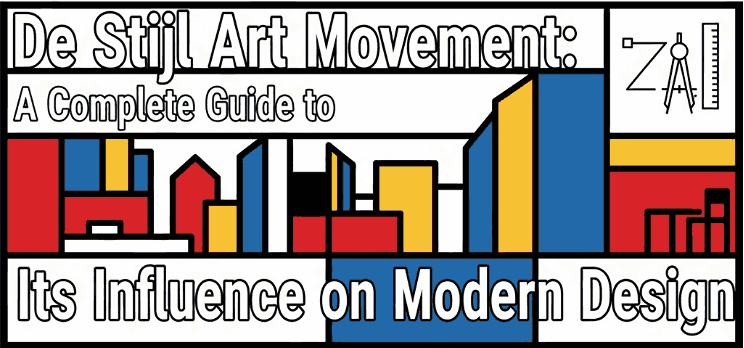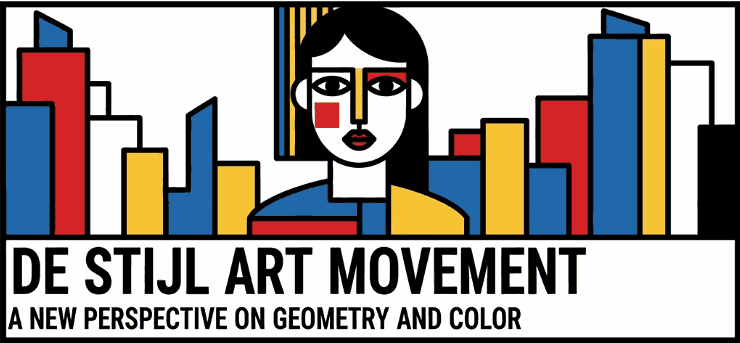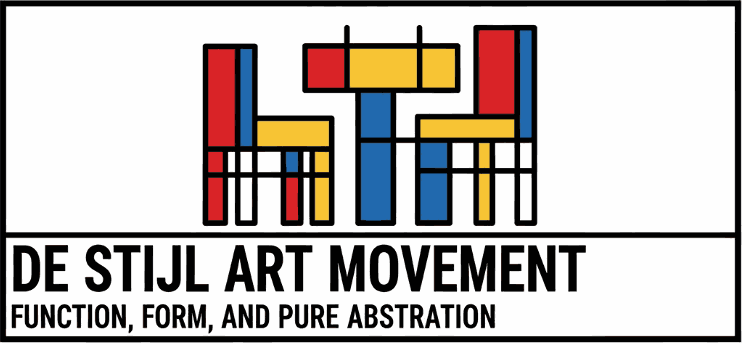
Table of Contents
- Introduction
- What Is the De Stijl Art Movement?
- The Origins of De Stijl
- Key Characteristics of De Stijl Design
- Influential Artists and Designers
- Why De Stijl Matters in Modern Graphic Design
- De Stijl in Contemporary Visual Culture
- How Designers Can Apply De Stijl Principles Today
- Recommended Fonts for De Stijl-Inspired Projects
- Conclusion
- References
1. Introduction De Stijl Art Movement
De Stijl Art Movement is one of the most influential modern art and design movements in history. Known for its bold abstraction, geometric shapes, and use of primary colors, De Stijl continues to shape everything from architecture and interior design to graphic design and typography.
For designers, understanding De Stijl is not just about studying history—it’s about learning how simplicity, balance, and structure can elevate visual communication. In this guide, we’ll dive deep into the origins, principles, and impact of De Stijl, and explore how you can apply its timeless concepts to your design projects today.

2. What Is the De Stijl Art Movement?
De Stijl (Dutch for “The Style”) is a Dutch artistic movement founded in 1917. It is also known as Neoplasticism, a term describing a new form of abstract, universal art. The movement rejects naturalistic representation and focuses instead on pure abstraction using:
- Straight horizontal and vertical lines
- Rectangular forms
- Primary colors (red, yellow, blue)
- Neutral colors (black, white, gray)
Its visual identity emphasizes harmony, balance, and reduction of form to its most essential elements.
3. The Origins of De Stijl Art Movement
The movement emerged during a period of social and cultural reinvention after World War I. Artists and designers sought a new aesthetic language that expressed order, clarity, and spiritual harmony.
Key figures such as Piet Mondrian and Theo van Doesburg believed that art should reflect universal beauty and purity. The result was a radical shift from decorative, organic styles to a more structured and mathematical approach to design.
4. Key Characteristics of De Stijl Art Movement Design
De Stijl is easily recognizable for its unique combination of geometry and color. Its key features include:
1. Pure Abstraction De Stijl Art Movement
Designs avoid natural forms and instead rely on abstract compositions.
2. Geometric Shapes De Stijl Art Movement
Squares and rectangles dominate, aligned along horizontal and vertical axes.
3. Primary Colors De Stijl Art Movement
Red, blue, and yellow are used to create striking yet harmonious visual contrasts.
4. Neutral Color Balance De Stijl Art Movement
Black, white, and gray add structure and stability.
5. Simplicity and Reduction De Stijl Art Movement
Unnecessary elements are eliminated, leaving only the essential components.
6. Strong Asymmetrical Balance
Though minimal, De Stijl compositions achieve dynamic balance through shape and proportion.
5. Influential Artists and Designers
Several key figures helped shape the De Stijl movement:
Piet Mondrian
The most famous De Stijl artist, Mondrian’s grid-based paintings embody the movement’s principles.
Theo van Doesburg
Founder of De Stijl magazine, he expanded the movement into architecture, typography, and design theory.
Gerrit Rietveld
Known for innovative furniture like the Red and Blue Chair and architecture such as the Rietveld Schröder House.
Vilmos Huszár & Bart van der Leck
Artists who contributed to the visual direction of early De Stijl.
Their work set the foundation for modern minimalism and the grid systems used widely in today’s design world.

6. Why De Stijl Matters in Modern Graphic Design
The De Stijl Art Movement continues to influence design in several ways:
a. Grid-Based Layouts
Modern web and editorial designs heavily rely on grid systems inspired by Mondrian’s compositions.
b. Minimalism
The movement’s focus on essential elements influenced minimalistic branding and UI/UX design.
c. Strong Color Theory
Primary and neutral color contrast is still used to create clarity and structure.
d. Architectural Harmony
Designers apply De Stijl principles when creating balanced, functional layouts.
e. Visual Identity Systems
Logo design, typography, and layout principles often echo the movement’s geometric approach.
De Stijl is timeless because its principles are universal, adaptable, and deeply rooted in visual logic.
7. De Stijl in Contemporary Visual Culture
De Stijl appears in today’s culture through:
- Brand identities
- Interior design and furniture
- Magazine layouts and book covers
- Website grid systems
- Fashion and product design
- Poster design and modern art exhibitions
Its clean geometry and bold color choices remain relevant because they communicate clarity and structure—qualities highly valued in modern communication.
8. How Designers Can Apply De Stijl Principles Today
Here are practical ways to incorporate De Stijl into modern design projects:
1. Use Bold Geometric Layouts De Stijl Art Movement
Break the canvas into rectangular fields using grids.
2. Highlight Visual Hierarchy De Stijl Art Movement
Utilize size and position to guide the viewer’s attention.
3. Restrict Color Usage De Stijl Art Movement
Stick to primary colors complemented by neutral tones.
4. Apply Thick Lines and Clear Dividers
These reflect the visual rhythm typical of Mondrian’s style.
5. Embrace Simplicity
Remove ornamentation and focus on structure, balance, and clarity.
6. Use Contrasting Typographic Styles
Pair clean, geometric typefaces with structured layouts for a contemporary De Stijl look.
9. Recommended Fonts for De Stijl-Inspired Projects
Fonts play a crucial role in expressing the structured and geometric style of De Stijl. Here are font recommendations from CalligraphyFonts.net that align well with De Stijl principles and are perfect for article mockups, posters, and branding:
1. Ballerinas Font
Although decorative, Ballerinas offers bold shapes and structured curves that can be adapted for modern De Stijl-inspired layouts, especially in posters or creative headlines.
2. Holters Sans Serif
A clean and geometric sans serif font that strongly resonates with De Stijl’s minimal and structured approach. Ideal for headers, editorial layouts, and graphic compositions.
3. Sublack Display Font
A striking display font with bold strokes and strong geometry—perfect for impactful De Stijl-styled posters, signage, and experimental layouts.
Using the right font enhances the visual identity of a De Stijl-inspired design and helps reflect the movement’s strong structural style.
10. Conclusion De Stijl Art Movement
The De Stijl Art Movement remains one of the most influential forces in modern design. Its core principles—geometry, simplicity, balance, and use of primary colors—are visible everywhere in contemporary visual communication. Designers who understand and apply De Stijl concepts can create work that is both timeless and visually striking.
By using structured layouts, bold shapes, and clean typography such as Holters, Sublack, and Ballerinas, you can bring the spirit of De Stijl into modern graphic design.
11. References
- Tate — Turner & Constable
- TheArtStory — Summary of De Stijl
- Moma — Art and artists in our collection
- DinStudio — De Stijl Design Movement: An Overview
